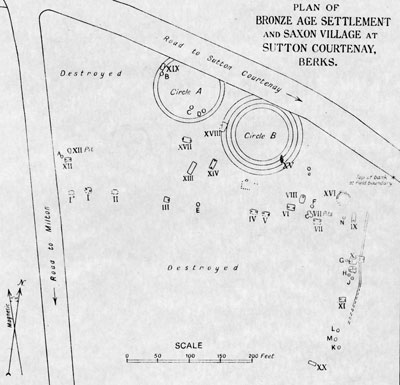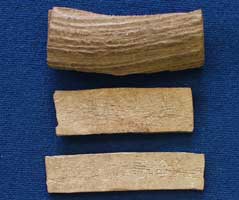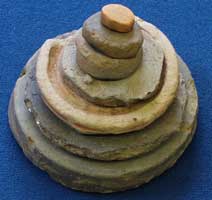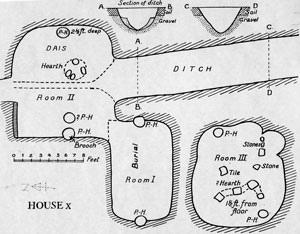| |
| |
| |
| |
| |
| |
ANGLO-SAXON OXFORDSHIRE
THE ANGLO-SAXON SETTLEMENT AT SUTTON COURTENAY
In 1921 E.T. Leeds discovered an early Anglo-Saxon settlement site at Sutton Courtenay. This site was important because it was the first early Anglo-Saxon settlement to be recognised and excavated in a systematic way. Leeds continued to excavate at this site during the 1920s and 1930s uncovering 33 dwellings, which are now known as sunken featured buildings or grubenhauser. These are buildings with a floor sunk into the ground and wooden posts to support the roof.

Most of the houses were orientated east to west; many having evidence of hearths and cooking pots indicating habitation on the site. Loomweights were found in several houses - espeically House XX - which together with finds of spindle whorls and thread pickers suggests weaving was done in these buildings. Bone objects such as combs and pins were also found in the houses, as were worked and unworked bone and antler. These finds, together with a horn core from one house, suggest that bone/antler working and other craft activities were probably occuring on this site in the Anglo-Saxon period.
 |
 |
|
Fragments of cut antler showing craft working on site |
Roman pottery found reused as gaming pieces and pot lids |
Artefacts of Roman origin were also found in some of the houses. Romano-British pottery was being reused for gaming pieces, spindle whorls and possibly as pot lids. Fragments of stamped Roman tile, three coins and two Romano-British brooches were also found on the site. These objects were probably collected from a nearby Roman site, since there is no other evidence of a Roman activity in the Anglo-Saxon village site.

Plan of the three rooms in House X
One of the houses was unusual in having three rooms (House X). In the centre of one room, beneath the floor, Leeds discovered the skeleton of a man, aged 30-40, buried with a knife and comb. The room appeared to have been used after the burial. In this same house, a silver-gilt equal-armed brooch was also found in the bottom of a post hole. This and other finds have been used to date the settlement from the fifth to sixth centuries.
The finds from this site provide us with a picture of everyday life in early Anglo-Saxon Oxfordshire. This was the first early Anglo-Saxon settlement site to be recognised but since 1921 hundreds more Anglo-Saxon settlements have been investigated.
|
See some of the finds from Sutton Courtenay
|
||
Part of the Anglo-Saxon settlement was also a Bronze Age site which E.T. Leeds also excavated. The finds from both these sites are now held by the Ashmolean Museum.
The Bronze Age site at Sutton Courtenay (link under construction)
REFERENCES:
E.T. Leeds (1923) "A Saxon Village near Sutton Courtenay, Berks", Archaeologia LXXII, p147-92.
E.T. Leeds (1927) "A Saxon Village near Sutton Courtenay, Berks (2nd report)", Archaeologia LXXVI, 59-79
E.T. Leeds (1947) "A Saxon Village near Sutton Courtenay, Berks (3rd report)", Archaeologia XCII, 79-93
A.L. Meaney (1964) A Gazetteer of Anglo-Saxon Burial Sites (London).